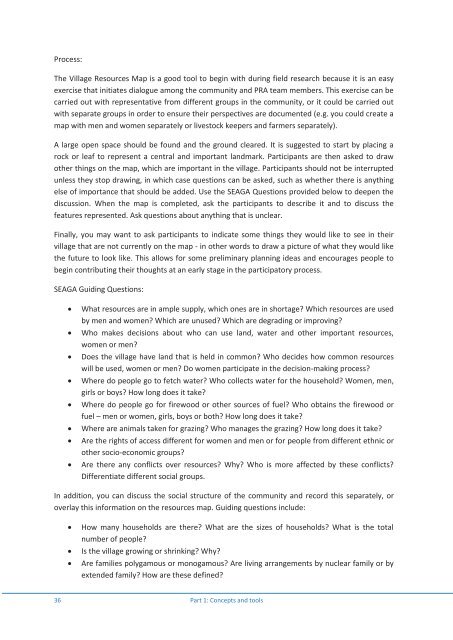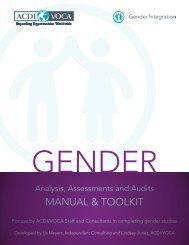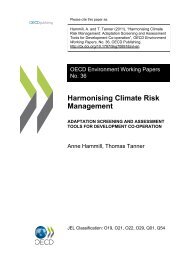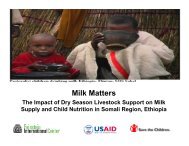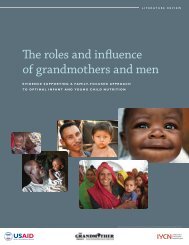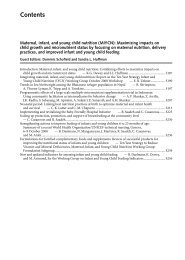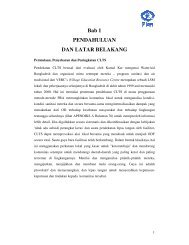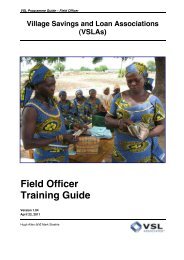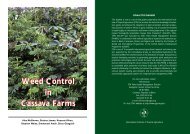Gender and climate change research in - FAO
Gender and climate change research in - FAO
Gender and climate change research in - FAO
You also want an ePaper? Increase the reach of your titles
YUMPU automatically turns print PDFs into web optimized ePapers that Google loves.
Process:<br />
The Village Resources Map is a good tool to beg<strong>in</strong> with dur<strong>in</strong>g field <strong>research</strong> because it is an easy<br />
exercise that <strong>in</strong>itiates dialogue among the community <strong>and</strong> PRA team members. This exercise can be<br />
carried out with representative from different groups <strong>in</strong> the community, or it could be carried out<br />
with separate groups <strong>in</strong> order to ensure their perspectives are documented (e.g. you could create a<br />
map with men <strong>and</strong> women separately or livestock keepers <strong>and</strong> farmers separately).<br />
A large open space should be found <strong>and</strong> the ground cleared. It is suggested to start by plac<strong>in</strong>g a<br />
rock or leaf to represent a central <strong>and</strong> important l<strong>and</strong>mark. Participants are then asked to draw<br />
other th<strong>in</strong>gs on the map, which are important <strong>in</strong> the village. Participants should not be <strong>in</strong>terrupted<br />
unless they stop draw<strong>in</strong>g, <strong>in</strong> which case questions can be asked, such as whether there is anyth<strong>in</strong>g<br />
else of importance that should be added. Use the SEAGA Questions provided below to deepen the<br />
discussion. When the map is completed, ask the participants to describe it <strong>and</strong> to discuss the<br />
features represented. Ask questions about anyth<strong>in</strong>g that is unclear.<br />
F<strong>in</strong>ally, you may want to ask participants to <strong>in</strong>dicate some th<strong>in</strong>gs they would like to see <strong>in</strong> their<br />
village that are not currently on the map - <strong>in</strong> other words to draw a picture of what they would like<br />
the future to look like. This allows for some prelim<strong>in</strong>ary plann<strong>in</strong>g ideas <strong>and</strong> encourages people to<br />
beg<strong>in</strong> contribut<strong>in</strong>g their thoughts at an early stage <strong>in</strong> the participatory process.<br />
SEAGA Guid<strong>in</strong>g Questions:<br />
<br />
<br />
<br />
<br />
<br />
<br />
<br />
<br />
What resources are <strong>in</strong> ample supply, which ones are <strong>in</strong> shortage Which resources are used<br />
by men <strong>and</strong> women Which are unused Which are degrad<strong>in</strong>g or improv<strong>in</strong>g<br />
Who makes decisions about who can use l<strong>and</strong>, water <strong>and</strong> other important resources,<br />
women or men<br />
Does the village have l<strong>and</strong> that is held <strong>in</strong> common Who decides how common resources<br />
will be used, women or men Do women participate <strong>in</strong> the decision-mak<strong>in</strong>g process<br />
Where do people go to fetch water Who collects water for the household Women, men,<br />
girls or boys How long does it take<br />
Where do people go for firewood or other sources of fuel Who obta<strong>in</strong>s the firewood or<br />
fuel – men or women, girls, boys or both How long does it take<br />
Where are animals taken for graz<strong>in</strong>g Who manages the graz<strong>in</strong>g How long does it take<br />
Are the rights of access different for women <strong>and</strong> men or for people from different ethnic or<br />
other socio-economic groups<br />
Are there any conflicts over resources Why Who is more affected by these conflicts<br />
Differentiate different social groups.<br />
In addition, you can discuss the social structure of the community <strong>and</strong> record this separately, or<br />
overlay this <strong>in</strong>formation on the resources map. Guid<strong>in</strong>g questions <strong>in</strong>clude:<br />
<br />
<br />
<br />
How many households are there What are the sizes of households What is the total<br />
number of people<br />
Is the village grow<strong>in</strong>g or shr<strong>in</strong>k<strong>in</strong>g Why<br />
Are families polygamous or monogamous Are liv<strong>in</strong>g arrangements by nuclear family or by<br />
extended family How are these def<strong>in</strong>ed<br />
36 Part 1: Concepts <strong>and</strong> tools


